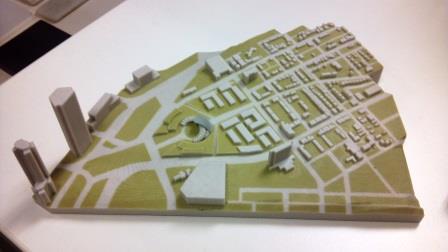

In this Edition
Construction
Management Specialists
111 Pine Street, Suite 1315
San Francisco, CA 94111
(415) 981-9430 (San Francisco office)
1663 Eureka Road
Roseville, CA 95661
(916) 742-1770 (Sacramento office)
9705 Cymbal Drive
Vienna, VA 22182
(703) 268-0852 (Washington, DC office)
4361 35th Street
San Diego, CA 92104
(619) 550-1187 (San Diego office)
8538 173rd Avenue NE
Redmond, WA 98052
(206) 571-0128 (Seattle office)
www.TBDconsultants.com
3-D printers started out as an expensive novelty, but prices have been dropping and they are now coming into the affordable bracket for many people. And the uses for them have been growing. Starting out as units that could build up objects from layers of plastic-like material, they can now handle a range of materials from chocolate to titanium. The uses people have been finding for the technology has similarly been expanding.
People have created flyable model aircraft, artistic furniture, robots, parts for 3-D printers, and some are hoping to create body organs for transplant. While a 3-D printer could, say, make the case for a cellphone, it couldn’t (at least at present) make the electronics inside, but people have come up with ways to do that. A team in Japan has adapted an inkjet printer so it can print electronic circuits on paper using ink containing silver nanoparticles.

A typical 3-D printer builds up an object by spreading a layer of whatever material is being used, fusing the required areas of the material together by means of the heat from the laser beam, then spreading another layer of the material and fusing the required areas to the lower layer, and so on. Finally the unfused material is brushed away and you have your object. The powder forming the layers might be something like polyamide plastic, stainless steel or titanium powder, and the thickness of each layer might be around 100 micrometers (one tenth of a millimeter or one two hundred and fiftieth of an inch). To make the object stronger, the printer could use an electron beam instead of a laser, so that it melts the material completely. The strength of the final product can be adjusted by fusing different materials together.
Another method such printers may use is to build up an object from thin layers of hot extruded plastic (or similar extrudable materials). Both methods build up an object by adding layers, so it is also known as additive manufacturing.
Not everyone that wants to use a 3-D printer actually needs to have one. There are plenty of online services that will take your design and print out the object for you and mail it to you. One such company providing this sort of service is Shapeways.com, who have some very useful tutorials as well.
And you may not even have to come up with the design of your object, because a lot of ready-made plans are published on the Internet. If you do need to create a design there are simple online tools available to do so. The age of individualized objects and innovation for everyone seems to have arrived – now you don’t have make something your own, you can make your own something.

Architects have made use of 3-D printers for many years for creating models of their designs, but how about printing the real thing, not just a model? People in many parts of the world are actually doing that.
Here in California, Contour Crafting is using a layered fabrication technology developed by Dr. Behrokh Khoshnevis of the University of Southern California that automates the construction of components and whole structures. Their system can be programmed to construct a series of houses (for example), where each house is different and the system includes making provision for plumbing, air-conditioning and electrical systems. While the process works fine here on earth, they are also thinking ahead to constructing buildings on the moon and Mars.
R-O-B Technologies of Zurich, Germany, has developed a mobile robotic construction platform that builds customized and complex brick structures, adhered with epoxy resin. The computer controlled robotic arm is ideal for placing bricks in special designs without the need for extensive layout and measurements, because the robotic arm can position itself, and the bricks, precisely.
A consortium in Europe that goes by the name of Amaze (Additive Manufacturing Aiming towards Zero waste and Efficient production of high-tech metal products) is developing techniques to print metal objects, including rocket motors.
Back here in the States, MIT Media Labs is developing a similar kinds of technology using robotic arm that can ‘print’ buildings. One idea being developed is called the Bots of Babel using cable-suspended fabrication robots that work together to build structures bigger than themselves. Another process being developed involves a swarm of small robotic agents that exude fast setting materials that might become structures or insulation, while incorporating MEP installations.
In the UK, Loughborough University’s Project Freeform uses robotics for material placement, and the project is also investigating the kinds of materials and construction techniques that work best with robot construction. They are working to produce components as well as full buildings.Teams around the world are working to develop the technology, with a first goal of developing a 3-D printed house. Almost every building tends to be a prototype, and this blends well with robotic construction, letting designers come up with some very imaginative designs, including a two-story house resembling a mobius strip.
Thanks to VITAL Environments for the images of the 3D models
Change is the big constant in life, and in this article we look at techniques for managing the changes that someone in the construction industry might come up against.
The economy seems to be changing for the better at long last, and in this article we look at some of the changes that we are likely to see in 2014.
Design consultant: Katie Levine of Vallance, Inc.